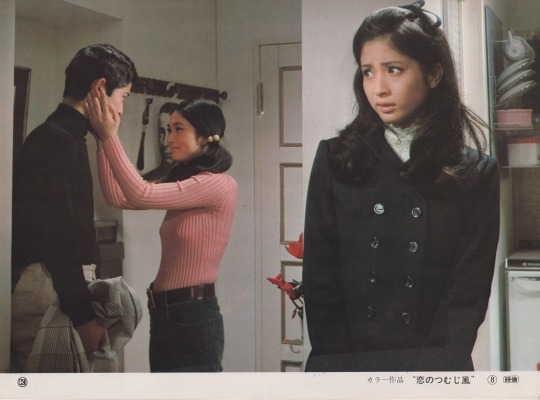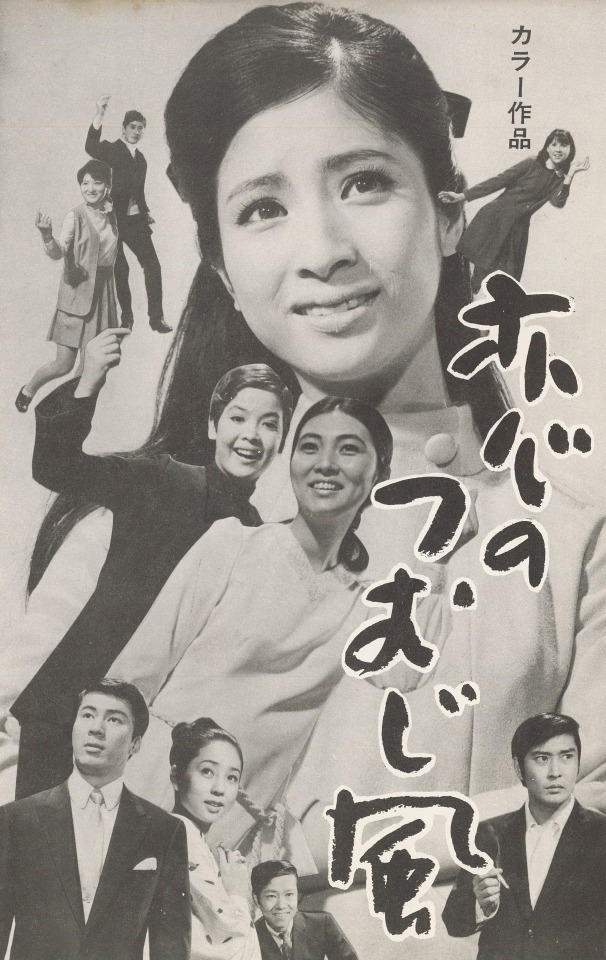#Chieko Wada
Explore tagged Tumblr posts
Text





Atami Blues (Donald Richie, 1962)
#Atami Blues#Donald Richie#1962#short film#Chieko Wada#black and white#interiors#japan#food#breakfast
444 notes
·
View notes
Text

Koji Wada (和田浩治), Meiko Kaji (梶芽衣子) and Chieko Matsubara (松原智恵子) in Whirlwind Of Love (恋のつむじ風), 1969, directed by Noboru Kaji (鍛治昇).
Scanned by me.
#Meiko Kaji#梶芽衣子#Chieko Matsubara#Koji Wada#Masako Ota#太田雅子#Whirlwind Of Love#Noboru Kaji#和田浩治#松原智恵子#恋のつむじ風#鍛治昇#scanned by me#lobby card
30 notes
·
View notes
Text

make me happy
2/12(月) @ 下北沢モナレコード
OPEN 19:00
Charge ¥2,500(D別)
[LIVE]
the 9MILES
CHIEKO BEAUTY &WADA MAMBO
Mexican Club Band
[DJ]
藤井悟
SUNSUKE
pope (クンビア商店 / FRANIIC BROWN BEAT!)
AKIRA UMEGAKI
0 notes
Photo

(Tomoe Gozen, by Tsukioka Yoshitoshi)
Tomoe, Yamabuki and Aoi - Lady samurais
Tomoe Gozen (12th-13th century) is probably the most famous Japanese warrior woman. “Gozen” wasn’t her surname, but a title that could be used for a lady of a distinguished family. Said title isn’t used in the chronicles, but it seems that it had become customary to address Tomoe this way by the 15th century. It was likely attributed to her due to a lineage of female performers specialized in telling Tomoe’s story, who used the title “Gozen” and took the name “Tomoe” to honor her memory.��
Though Tomoe’s story probably has a factual basis, separating fact from fiction remains difficult. What’s known comes from oral traditions that began to be conveyed in written form at the end of the 13th century. Different versions thus exist. She was likely born around 1157 and possibly died in 1247, though the latter remains uncertain.
In the most commonly accepted version, Tomoe’s father was a warrior named Nakahara Kaneto and she had two brothers: Imai Kanehira and Higuchi Kanemitsu. Her mother was the wet nurse of Minamoto no Yoshinaka , who was fostered in their family in Kiso Valley. The relationship between Tomoe and Yoshinaka is unclear. Only one version of her story tells that she was his concubine while the others are silent. It’s thus possible for such elements to be romantic embellishments. Since young women from samurai families were taught the fighting arts, this is probably how Tomoe acquired her military skills.
Tomoe showed her bravery during the Genpei war, a civil war who opposed the Minamoto clan to the Taira. An interesting point is that the different sources give a coherent picture of Tomoe’s military career. The most well-known account of her story, the Tale of the Heike, gives the following description of Tomoe:
“Tomoe was especially beautiful, with white skin, long hair, and charming features. She was also a remarkably strong archer, and as a swordswoman she was a warrior worth a thousand, ready to confront a demon or god, mounted or on foot. She handled unbroken horses with superb skill; she rode unscathed down perilous descents. Whenever a battle was imminent, Yoshinaka sent her out as his first captain, equipped with strong armor, an oversized sword, and a mighty bow; and she performed more deeds of valor than any of his other warriors.”
She first fought during the battle of Yokotagawara in 1181 and killed seven enemy cavalrymen. She then led 1,000 men during the battle of Kurikara in 1183, making her one of Yoshinaka’s main commanders. Some tellings of the battle credit her with creating the tactic that made victory possible. She reportedly had torches attached to the horns of bulls while some of her soldiers were beating the drums. The confusion caused the enemy’s horses to panic and it is said that 70,000 Taira soldiers perished that day. Though this number is certainly exaggerated, the victory was certainly a decisive one.
Yoshinaka then took Kyoto, at that time Japan’s capital, in July in 1183 after the Taira had fled the city. He made himself extremely unpopular, executing his opponents, while his troops were raping and plundering. In January 1184, the cloistered emperor Go-Shirakawa asked Minamoto no Yoritomo, Yoshinaka’s cousin, to expel him from the city. Since Yoritomo and Yoshinaka were rivals, Yoritomo accepted.
Yoshinaka thus had to flee. Tomoe followed him as his “first commander” and personal bodyguard. During the battle of Uchide no Hama, Yoshinaka’s 300 cavalrymen faced 6,000 enemy soldiers. Tomoe was one of the few survivors and managed to escape capture. She then fought a last time at Awazu in February 1184. In the Tale of the Heike, Yoshinaka orders her to leave and, humiliated, she confronts and beheads a particularly strong warrior in order to show her might one last time.
All the versions of her story have Yoshinaka tell that he didn’t want to die alongside a woman. Though Tomoe’s warrior pride was wounded, she had no choice, but to obey. She took off her armor and left the battlefield. Yoshinaka died a humiliating death, killed as he tried to flee. What happened to her afterward is the subject of many stories. One says that she was captured and brought in front of Yoritomo. A warrior named Wada Yoshimori fell in love with her and married her to have her spared. She gave birth to a son a became a nun after his death. This is, however, unlikely.
Numerous towns and provinces claim to be the place where Tomoe spent the rest of her life. A study showed the existence of several Buddhist nuns named Tomoe in different locations, but none of them has been proved to be the warrior woman. At tomb attributed to her can be seen in Gichû-ji temple, next to Yoshinaka’s grave. It is said that Tomoe lived in this temple and that her ghost can be seen haunting its courtyard. What is certain, however, is that many tales circulated about Tomoe, certainly conveyed by itinerant performers, which led to this blend of facts and legends.
Last, but not least, Tomoe isn’t the only female warrior mentioned in tellings of the Genpei war. The Tale of the Heike states that Yoshinaka went to war with two women: Tomoe and Yamabuki. Yamabuki had, however, fallen sick and had to be left in Kyoto. No mention is made of Yamabuki in the other main version, the Genpei-seisui-ki, who states that Yoshinaka had another female commander named Aoi and that she died during the battle of Kurikara.
The exact truth can’t be known, but local traditions attached to both Yamabuki and Aoi exist. For instance, it’s possible to visit in Kiso valley the house where Yamabuki reportedly lived while commemorative steles have been erected to Tomoe and Aoi on the site of Kurikara. Those names nonetheless suggest that Tomoe’s story can be seen as part of a bigger picture. Since archeological discoveries may suggest that women were involved in armies on a larger scale than expected, it seems that Tomoe wasn’t perhaps a lone exception.
Tomoe’s story has inspired noh and kabuki plays. A geiko dressed as her appears every year during Kyoto’s festival of the ages.
Bibliography:
Brown Steven T., Theatricalities of power, the cultural politics of noh
Doak Kevin M., “Tomoe Gozen”, in: Pennington Reina (ed.), Amazons to fighter pilots,Biographical dictionary of military women vol.2
McCullough Helen Craig (trad.), The tale of the Heike
Oyler Elizabeth, “The woman warrior Tomoe in medieval and early modern Japanese nō plays”,in: Wade Mara R. (dir.), Gender matters: discourses of violence in early modern literature and the arts
Oyler Elizabeth, “The battle of Tonamiyama in Bangai nō”, in: Oyler Elizabeth, Watson Michael (dir.), Like clouds and mists: Studies and translations of nō plays from the Genpei war
Scott Wilson William, Walking the kiso road, a modern day exploration of old Japan
Watson Michael, “Kurikara Otoshi (The fall from Kurikara): Introduction”, in: Oyler Elizabeth, Watson Michael (dir.), Like clouds and mists: Studies and translations of nō plays from the Genpei war
Tyler Royall, “Tomoe, the woman warrior”, in: Mulhern Chieko Irie (dir.), Heroic with grace: legendary women of Japan
#Tomoe gozen#aoi#yamabuki#onna bugeisha#lady samurai#samurai#genpei war#12th century#japan#Japanese history#history#war#military history#women in history#women's history#warrior women#women in war#badass women
403 notes
·
View notes
Text
九月!/ September!
第一時間 / First Hour:
緑黄色社会 - 真夜中ドライブ - 緑黄色社会 Momoko Kikuchi - Glass no Sogen - Glass no Sogen Bump of Chicken - 宝石になった日 - Butterflies あさぎーにょ - Kitai - Kitai ***Maison Book Girl - レインコートと首の無い鳥 - elude Eve - トーキョーゲット - トーキョーゲット Bump of Chicken - 天体観測 - jupiter World Order - The Next Phase - Singularity 吉田律 - bad morning - bad morning Spyair - 0 game - 0 game The Guo Brothers, Shung Tian - Soldiers of the Long March - Yuan Agatsuma - Distant City - En
第二時間 / Second Hour:
Yoshida Brothers - Ajigasawa Jinku - Hishou The Guo Brothers, Shung Tian - Three Kingdoms - Yuan Kodo - A-Son-Ja-O - Ibuki The Ondekoza - Tsugaru Jamisen II - The Ondekoza Sekai no Owari - Dragon Night - Tree Saury - 君に会いたい - Sheer Fantasy Khac Chi Ensemble - Native Land - Moonlight in Vietnam Shonen Knife - Devil House - Pretty Little Baka Guy Goose House - 光なら - Goose House Phrase #13 Fly High, So High Bradio - Flyers - Flyers Wada Koji - Butterfly (Cover by Raon Lee) - re-fly Goose House - カントリー・ロード - カントリー・ロード
第三時間 / Third Hour:
Miree - IDOL (Original BTS) - Love Yourself Mingoz ft. the Brotherhood - Despacito (Original Luis Fonsi) - Despacito (Japanese Cover) Hello Sleepwalkers - 新世界 - シンセカイ 黒夢 - autism -自閉症- - 迷える百合達〜Romance of Scarlet〜 Aimer - カタオモイ - daydream YeYe - うんざりですよ - MOTTAINAI TENDRE - RIDE - SOFTLY-RIDE ***SIRUP - LOOP - SIRUP EP2 Alcvin Ryuzen Ramos - Gaia's Lullaby - Japanese Bamboo Flute Shakuhachi Chieko Mori - Midare - Katyou Fuugetsu
#kuci#kucifm#kuci 88.9fm#radio#internet radio#playlist#プレイリスト#radio of the rising sun#radiooftherisingsun#旭日のラジオ
3 notes
·
View notes
Photo

上田麗奈 “RefRain”
Art Direction&Design : CHIEKO YAMAMOTO
Photography : ARATA KATO
Styling : TSUBASA SHIMODA
Hair&Make-up : MAKIKO WADA
Flower Coodinate : KAYO KUWAHARA(Greenhouse301)
0 notes
Text



Atami Blues (Donald Richie, 1962)
402 notes
·
View notes
Text











Atami Blues (Donald Richie, 1962)
#films watched in 2024#Atami Blues#Donald Richie#1962#short film#Chieko Wada#black and white#Tomosuke Suzuki#seis#love#Tôru Takemitsu#Hidetoshi Hirano#music#water#bath#sunglasses#back#bed
117 notes
·
View notes
Text


Atami Blues (Donald Richie, 1962)
#Atami Blues#Donald Richie#1962#short film#Chieko Wada#beauty#eyes#sleep#black and white#train#trains
105 notes
·
View notes
Photo

Chieko Matsubara (松原智恵子), Meiko Kaji (梶芽衣子), Teruko Hasegawa (長谷川照子) and the rest in Whirlwind Of Love (恋のつむじ風), 1969, directed by Noboru Kaji (鍛治昇).
Scanned from a promo flyer.
http://meikokaji.net/
#Meiko Kaji#梶芽衣子#Chieko Matsubara#Noboru Kaji#Teruko Hasegawa#Whirlwind Of Love#松原智恵子#長谷川照子#恋のつむじ風#鍛治昇#Ryotaro Sugi#杉良太郎#Koji Wada#和田浩治#scanned by me#poster#flyer
24 notes
·
View notes
Photo

Koji Wada (和田浩治), Meiko Kaji (梶芽衣子) and Chieko Matsubara (松原智恵子) in a lobby card for Whirlwind Of Love (恋のつむじ風), 1969, directed by Noboru Kaji (鍛治昇).
http://fuckyeahmeikokaji.tumblr.com/
#Meiko Kaji#梶芽衣子#Chieko Matsubara#Koji Wada#Masako Ota#太田雅子#Whirlwind Of Love#Noboru Kaji#和田浩治#松原智恵子#恋のつむじ風#鍛治昇#scanned by me#lobby card
34 notes
·
View notes